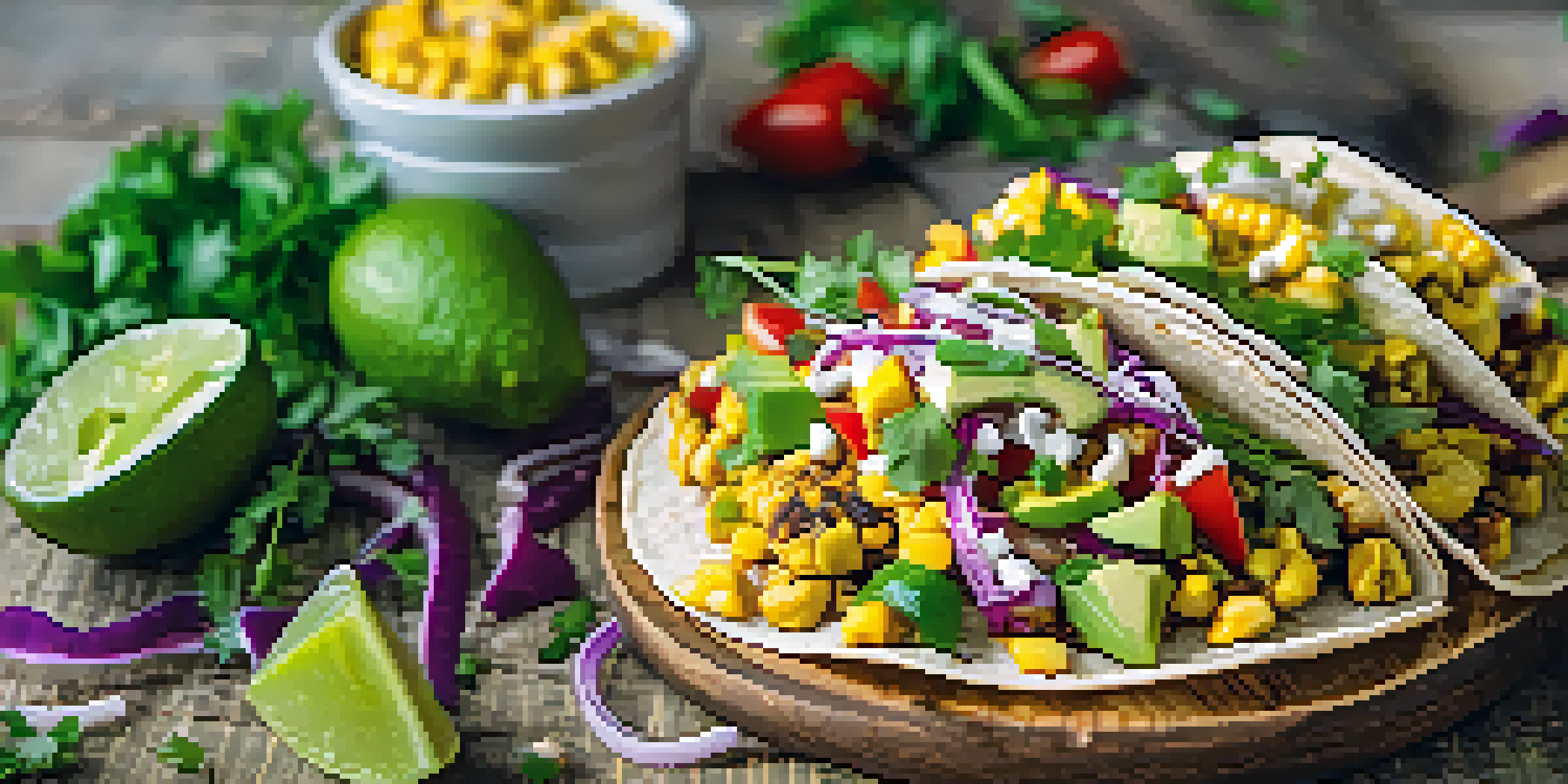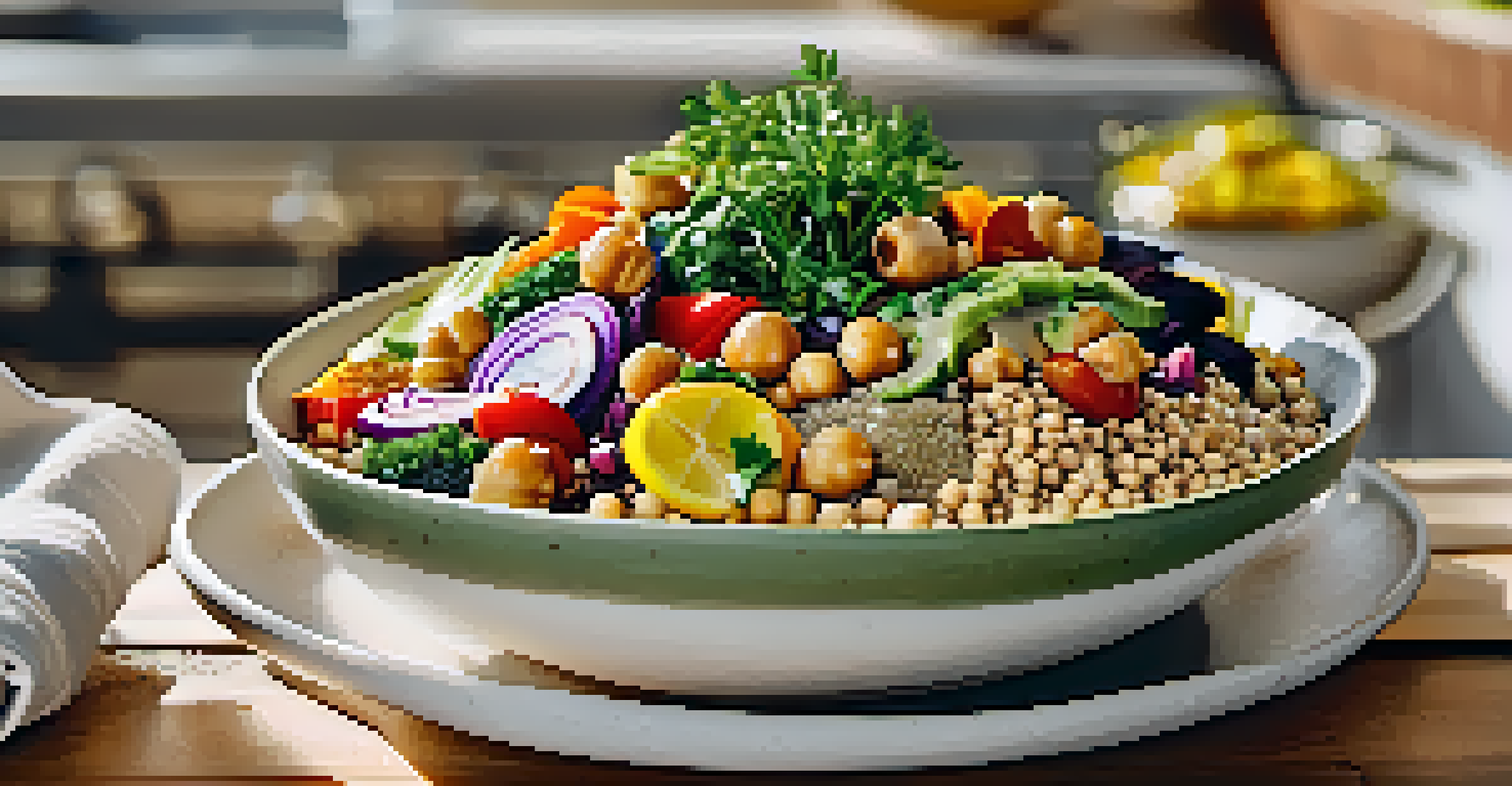Vegan Fusion Cuisine: Blending Traditions from Around the World

What is Vegan Fusion Cuisine and Why It Matters
Vegan fusion cuisine is an innovative culinary approach that blends traditional vegan recipes with flavors and techniques from diverse cultures. This style of cooking not only caters to plant-based diets but also celebrates the rich tapestry of global cuisines. By combining ingredients and methods from different culinary traditions, vegan fusion opens up a world of creative possibilities on your plate.
Food is not just what you eat, but how you eat it, and what it means to you and your community.
Imagine enjoying a spicy Thai curry infused with Indian spices, or a Mexican taco filled with Mediterranean falafel. These unexpected pairings not only tantalize the taste buds but also encourage culinary exploration and appreciation for various cultures. It's about breaking down barriers in the kitchen and inviting everyone to the table, regardless of their dietary preferences.
As more people turn to plant-based diets for health, environmental, and ethical reasons, vegan fusion cuisine plays an essential role in making veganism accessible and enjoyable. This movement encourages chefs and home cooks alike to experiment with ingredients, pushing culinary boundaries while maintaining a focus on sustainability.
Exploring Asian Influences in Vegan Fusion Dishes
Asian cuisines are rich in flavors and techniques that lend themselves beautifully to vegan fusion. From the umami-packed soy sauce of East Asian dishes to the aromatic spices of Southeast Asian curries, there's no shortage of inspiration. For instance, a classic Japanese ramen can be transformed into a vegan delight using plant-based broths and tofu as a protein source.

Consider a green curry that incorporates jackfruit as a meat substitute, offering a unique texture that surprises and delights. The versatility of ingredients like tofu, tempeh, and various vegetables allows for endless creativity, making it easier to craft dishes that appeal to a wide audience. This fusion not only celebrates the essence of traditional recipes but also introduces new ways to enjoy familiar flavors.
Vegan Fusion Celebrates Diversity
Vegan fusion cuisine combines traditional vegan recipes with flavors from various cultures, promoting culinary exploration and accessibility.
Furthermore, Asian-inspired vegan fusion dishes can often be made quickly and easily, making them a favorite for busy weeknights. With dishes like vegan sushi rolls or stir-fried noodle bowls, you can whip up a delicious meal that transports you across the globe without leaving your kitchen.
Latin American Flavors: A Vegan Twist on Tradition
Latin American cuisine is renowned for its bold flavors and vibrant ingredients, making it a perfect match for vegan fusion. Dishes like tacos, enchiladas, and empanadas can be reimagined with plant-based fillings like lentils, black beans, and roasted vegetables. This not only maintains the beloved flavors of these dishes but also adds a healthy twist that everyone can enjoy.
Cooking is like love. It should be entered into with abandon or not at all.
Imagine biting into a taco filled with spicy, grilled corn and avocado, topped with a zesty lime crema made from cashews. This delicious fusion not only satisfies cravings but also showcases the beauty of combining traditional ingredients with vegan alternatives. The result is a delightful celebration of flavors that honors both the original recipes and the plant-based movement.
Additionally, the use of fresh herbs and spices in Latin American cooking can elevate vegan dishes to new heights. A simple cilantro-lime dressing can transform a salad, while a smoky chipotle sauce can add depth to a grain bowl. These flavors make vegan fusion not only accessible but also downright irresistible.
Mediterranean Magic: Harnessing Fresh Ingredients
Mediterranean cuisine is a treasure trove of fresh ingredients, making it a natural fit for vegan fusion. With an emphasis on vegetables, legumes, and grains, Mediterranean dishes can easily be adapted to suit a plant-based lifestyle. Think of a hearty Mediterranean grain bowl filled with quinoa, roasted vegetables, and a drizzle of tahini dressing for a delightful meal.
Dishes like stuffed grape leaves or ratatouille can be easily veganized while retaining their authentic flavors. By using ingredients such as chickpeas, olives, and fresh herbs, you can create satisfying meals that are both nutritious and flavorful. This cuisine offers a wonderful canvas for experimentation, allowing you to mix and match ingredients from various cultures.
Asian Influences Enhance Creativity
Asian cuisines offer rich flavors and techniques that inspire innovative vegan dishes, making meals both exciting and quick to prepare.
Furthermore, Mediterranean vegan fusion dishes often embrace health-conscious elements, making them appealing to a broad audience. The focus on wholesome ingredients means you can enjoy delicious meals that are as good for your body as they are for your taste buds.
The Art of Flavor Pairing: A Culinary Journey
Flavor pairing is a crucial aspect of any fusion cuisine, and vegan dishes are no exception. Understanding how different flavors interact can help you create dishes that are both harmonious and exciting. For instance, pairing sweet and savory ingredients, like roasted sweet potatoes with a spicy tahini sauce, can elevate a simple dish into something extraordinary.
Consider the classic combination of peanut butter and banana, which can be reimagined in a vegan fusion context by adding a touch of chili for heat or drizzling with maple syrup for sweetness. This kind of creative thinking allows you to redefine familiar flavors while exploring new combinations that can surprise and delight.
Moreover, experimenting with textures can also enhance your culinary creations. Mixing crunchy, creamy, and chewy elements can make a dish more enjoyable to eat. Using ingredients like crispy roasted chickpeas alongside creamy avocado in a salad creates a delightful contrast that keeps each bite interesting.
Seasonal and Local: The Heart of Vegan Fusion Cuisine
One of the joys of vegan fusion cuisine is its flexibility, allowing you to incorporate seasonal and local ingredients. By focusing on what's fresh and available in your area, you can create dishes that not only reflect your culinary style but also support local farmers and businesses. This approach not only enhances the flavor of your meals but also contributes to a more sustainable food system.
For instance, using summer's bounty of ripe tomatoes and cucumbers can inspire a refreshing Mediterranean salad, while autumn's harvest of squash and root vegetables can lead to hearty stews or grain bowls. This adaptability encourages creativity in the kitchen, as you find new ways to incorporate seasonal produce into your meals.
Local Ingredients Foster Sustainability
Incorporating seasonal and local ingredients into vegan fusion dishes enhances flavor and supports sustainable food practices.
Additionally, embracing local ingredients fosters a sense of connection to your community and the environment. It allows you to celebrate the unique flavors of your region while crafting dishes that resonate with your personal culinary journey.
Bringing It All Together: Crafting Your Own Vegan Fusion Meals
Now that you've explored the various influences of vegan fusion cuisine, it's time to bring it all together and craft your own meals. Start by selecting a base, such as grains, legumes, or vegetables, and then think about flavors and techniques you want to incorporate. Whether it's a spicy curry, a fresh salad, or a comforting stew, the possibilities are endless.
Don't hesitate to experiment with ingredients that reflect your favorite cuisines. If you love Italian flavors, try adding pesto to a grain bowl, or if you're a fan of Indian spices, incorporate garam masala into roasted veggies. The key is to have fun with it and let your culinary instincts guide you toward delicious outcomes.

Lastly, remember that vegan fusion cuisine is about more than just food; it's about culture, creativity, and connection. Share your dishes with friends and family, and invite them to join in on the exploration of flavors from around the world. This communal experience not only enhances the joy of cooking but also fosters a greater appreciation for the diverse culinary traditions that inspire us all.